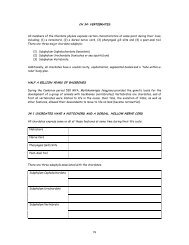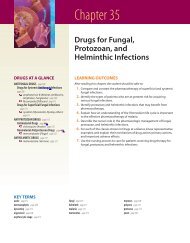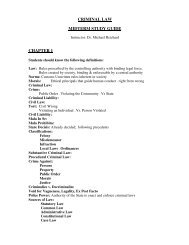Antimicrobial Drugs
Antimicrobial Drugs
Antimicrobial Drugs
You also want an ePaper? Increase the reach of your titles
YUMPU automatically turns print PDFs into web optimized ePapers that Google loves.
M34_ADAM9811_03_SE_CH34.QXD 12/30/09 1:16 PM Page 492<br />
492 Unit 5 The Immune System<br />
TABLE 34. 7 Fluoroquinolones<br />
Drug Route and Adult Dose (max dose where indicated) Adverse Effects<br />
FIRST GENERATION<br />
cinoxacin (Cinobac) PO; 250–500 mg bid–qid Nausea, diarrhea, vomiting, rash, headache,<br />
nalidixic acid (NegGram) PO; Acute therapy: 1 g qid<br />
restlessness, pain and inflammation at injection<br />
site, local burning, stinging and corneal irritation<br />
PO; Chronic therapy: 500 mg qid<br />
(ophthalmic)<br />
SECOND GENERATION<br />
Anaphylaxis, tendon rupture, superinfections,<br />
ciprofloxacin (Cipro)<br />
PO; 250–750 mg bid<br />
photosensitivity, pseudomembranous colitis,<br />
seizure, peripheral neuropathy, hepatotoxicity<br />
norfloxacin (Noroxin)<br />
ofloxacin (Floxin)<br />
THIRD GENERATION<br />
PO; 400 mg bid or 800 mg once daily<br />
PO; 200–400 mg bid (max: 800 mg/day)<br />
gatifloxacin (Zymar)<br />
levofloxacin (Levaquin)<br />
FOURTH GENERATION<br />
Drops (0.3% ophthalmic solution); On days 1 and 2, one drop in each affected eye<br />
every 2 hours; on days 3–7, one drop in each affected eye up to four times/day<br />
PO; 250–500 mg/day (max: 750 mg/day)<br />
gemifloxacin (Factive)<br />
PO; 320 mg/day (max: 320 mg/day)<br />
moxifloxacin (Avelox)<br />
PO/IV; 400 mg/day (max: 400 mg/day)<br />
Italics indicate common adverse effects; underlining indicates serious adverse effects.<br />
A major advantage of the fluoroquinolones is that most<br />
are well absorbed orally and may be administered either<br />
once or twice a day. Although they may be taken with food,<br />
they should not be taken concurrently with multivitamins<br />
or mineral supplements because calcium, magnesium, iron,<br />
or zinc ions can reduce the absorption of some fluoroquinolones<br />
by as much as 90%.<br />
Fluoroquinolones are well tolerated by most patients, with<br />
nausea, vomiting, and diarrhea being the most common adverse<br />
effects. The most serious adverse effects are dysrhythmias<br />
(gatifloxacin and moxifloxacin) and potential<br />
hepatotoxicity. Central nervous system effects such as dizziness,<br />
headache, and sleep disturbances affect 1% to 8% of patients.<br />
Most recently, fluoroquinolones have been associated<br />
with an increased risk of tendonitis and tendon rupture, particularly<br />
of the Achilles tendon. The risk of tendon rupture is<br />
increased in patients over age 60 and those receiving concurrent<br />
corticosteroids. Because animal studies have suggested<br />
that fluoroquinolones affect cartilage development, these<br />
drugs are not approved for children under age 18. Use in pregnancy<br />
or in lactating patients should be avoided.<br />
See Nursing Process Focus: Patients Receiving Antibacterial<br />
Therapy on page 496 for the Nursing Process applied to<br />
all antibacterials.<br />
Sulfonamides<br />
Sulfonamides are older drugs that have been prescribed for<br />
a variety of infections over the past 70 years. Although their<br />
use has declined, sulfonamides are still useful in treating<br />
susceptible UTIs. The sulfonamides are listed in Table 34.8.<br />
34.14 Pharmacotherapy<br />
with Sulfonamides<br />
The discovery of the sulfonamides in the 1930s heralded a<br />
new era in the treatment of infectious disease.With their wide<br />
spectrum of activity against both gram-positive and gramnegative<br />
bacteria, the sulfonamides significantly reduced<br />
mortality from susceptible microbes and earned their discoverer<br />
a Nobel Prize in Medicine. Sulfonamides are bacteriostatic<br />
and active against a broad spectrum of microorganisms.<br />
Sulfonamides suppress bacterial growth by inhibiting the<br />
synthesis of folic acid, or folate. These drugs are sometimes<br />
referred to as folic acid inhibitors. In human physiology, folic<br />
acid is a B-complex vitamin that is essential during periods<br />
of rapid growth, especially during childhood and pregnancy.<br />
Bacteria also require this substance during periods of<br />
rapid cell division and growth.<br />
Although initially very effective, several factors led to a significant<br />
decline in the use of sulfonamides. Their widespread<br />
availability for over 60 years resulted in a substantial number<br />
of resistant strains. The discovery of the penicillins,<br />
cephalosporins, and macrolides gave physicians larger<br />
choices of safer agents. Approval of the combination antibiotic<br />
sulfamethoxazole–trimethoprim (Bactrim, Septra,<br />
TMP-SMZ) marked a resurgence in the use of sulfonamides<br />
in treating UTIs. In communities with high resistance rates,<br />
however, TMP-SMZ is no longer a drug of first choice, unless<br />
C&S testing determines it to be the most effective drug for the<br />
specific pathogen. Sulfonamides are also prescribed for the<br />
treatment of Pneumocystis carinii pneumonia and shigella<br />
infections of the small bowel. Sulfasalazine (Azulfidine) is a<br />
# 102887 Cust: PE/NJ/CHET Au: ADAMS Pg. No. 492<br />
Title: Pharmacology for Nurses Server: Jobs2<br />
C/M/Y/K<br />
Short / Normal<br />
DESIGN SERVICES OF<br />
S4CARLISLE<br />
Publishing Services

















